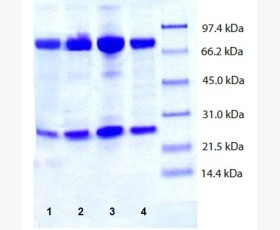Recombinant Human Oncomodulin-1/OM
| Product name: | Recombinant Human Oncomodulin-1/OM |
| Source: | E.coli |
| Purity: | Greater than 95% as determined by reducing SDS-PAGE. |
| Buffer Formulation: | Lyophilized from a 0.2 μm filtered solution of 50mM Tris, 100mM NaCl, pH 7.5. |
| Applications: | Applications:SDS-PAGE; WB; ELISA; IP. |
| Storage: | Avoid repeated freeze/thaw cycles. Store at 2-8 oC for one month. Aliquot and store at -80 oC for 12 months. |
| UOM: | 100ug/50ug/200ug/1mg/1g |
| Source | E.coli |
| Description | Recombinant Human Oncomodulin-1 is produced by our E.coli expression system and the target gene encoding Met1-Ser109 is expressed with a 6His tag at the N-terminus. |
| Names | Oncomodulin-1, OM, Parvalbumin Beta, OCM, OCM1, OCMN |
| Accession # | P0CE72 |
| Formulation | Lyophilized from a 0.2 μm filtered solution of 50mM Tris, 100mM NaCl, pH 7.5. |
| Shipping |
The product is shipped at ambient temperature. |
| Reconstitution |
Always centrifuge tubes before opening. Do not mix by vortex or pipetting. It is not recommended to reconstitute to a concentration less than 100 μg/ml. Dissolve the lyophilized protein in ddH2O. Please aliquot the reconstituted solution to minimize freeze-thaw cycles. |
| Storage |
Lyophilized protein should be stored at < -20°C, though stable at room temperature for 3 weeks. Reconstituted protein solution can be stored at 4-7°C for 2-7 days. Aliquots of reconstituted samples are stable at < -20°C for 3 months. |
| Purity |
Greater than 95% as determined by reducing SDS-PAGE. |
| Endotoxin | Less than 0.1 ng/µg (1 IEU/µg) as determined by LAL test. |
| Amino Acid Sequence |
MGSSHHHHHHSSGLVPRGSHMSITDVLSADDIAAALQECRDPDTFEPQKFFQTSGLSKMSANQVK DVFRFIDNDQSGYLDEEELKFFLQKFESGARELTESETKSLMAAADNDGDGKIGAEEFQEMVHS
|
| Background | Oncomodulin-1 (OM) is a small, calcium-binding protein and a macrophage-derived growth factor, which can promote axon regeneration in retinal ganglion cells. Oncomodulin-1 is constitutively secreted by activated macrophages in the vitreous and retina in response to inflammatory conditions that promote optic nerve regeneration. Oncomodulin-1 binds RGCs with high affinity in vitro, but only when cAMP is pharmacologically elevated or if the membrane is permeabilized allowing Oncomodulin-1 access to the cytosolic compartment. Oncomodulin-1 is a member of the superfamily of calmodulin proteins and is a high-affinity calcium ion-binding protein and contains 2 EF-hand domains. OM is found in early embryonic cells in the placenta and also in tumors. It has some calmodulin-like activity with respect to enzyme activation and growth regulation. |














